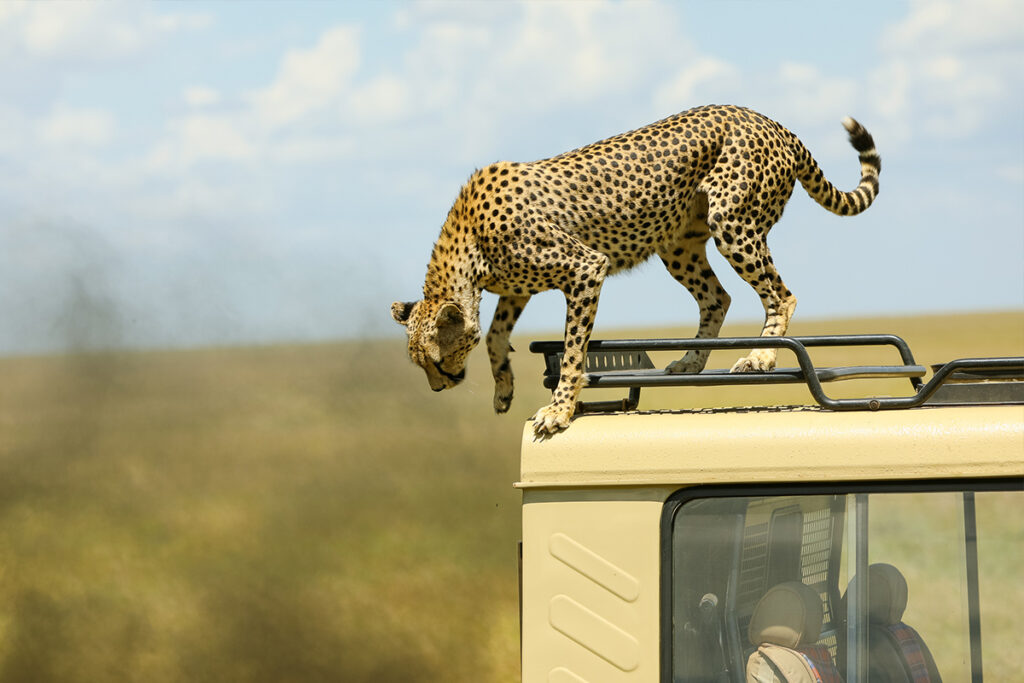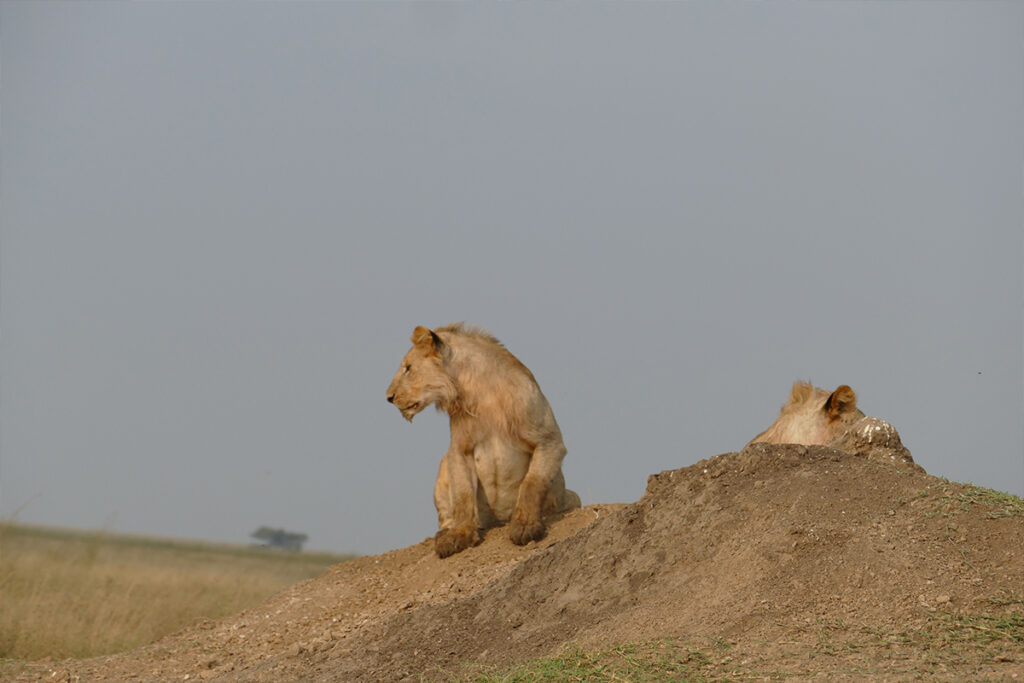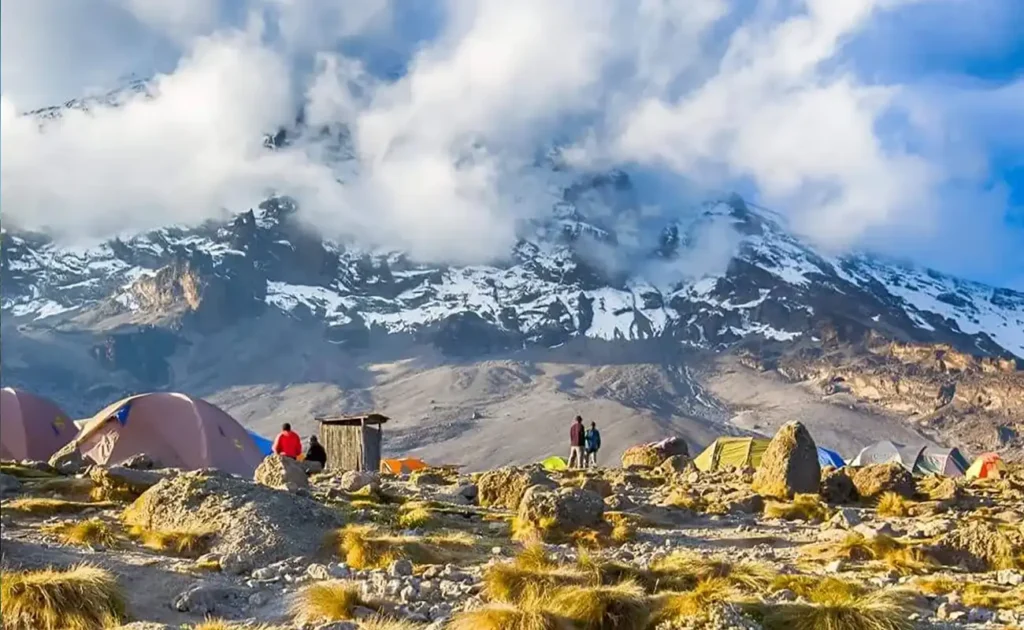Home to one of the largest concentrations of black rhinos in East Africa, Tanzania’s Ngorongoro Conservation Area offers a unique glimpse into the life of this critically endangered species. This UNESCO World Heritage site is a biodiversity hotspot that attracts wildlife enthusiasts and experts alike, seeking an authentic and rare wilderness experience. The thrill of spotting a rhino in its natural habitat, set against the backdrop of the majestic Ngorongoro Crater, is simply unparalleled.
Established in 1959, the Ngorongoro Conservation Area balances conservation, tourism, and the needs of local communities. Covering over 8,300 square kilometers, it’s home to more than 25,000 large animals, including approximately 55 black rhinos. A rhino safari here not only supports the preservation of these iconic creatures but also promotes sustainable tourism practices essential for the area’s long-term ecological health.

Exploring the Ngorongoro Conservation Area
The Ngorongoro Conservation Area in Tanzania is a special place known for its amazing landscapes and diverse wildlife. It’s a favorite spot for adventurers and nature lovers from all over the world. The area covers around 8,300 square kilometers and is home to the famous Ngorongoro Crater. This crater is an extinct volcanic caldera and one of the most breathtaking natural wonders. Here in the crater, you can find an incredible variety of animals, including lions, elephants, and rhinos.
The Ngorongoro area also has a rich history. It was designated a UNESCO World Heritage site in 1979. This shows its importance not only in wildlife conservation but also in cultural heritage. According to here is the article, the Maasai people have lived here for hundreds of years, coexisting with the wildlife. This unique balance of nature and human life makes Ngorongoro a fascinating place to explore.
For those planning a visit, timing is essential. The best time to go on a safari is during the dry season from June to October. The dry season makes it easier to see animals as they gather around water sources. In contrast, the wet season from November to May still offers incredible sights. However, some roads might be more challenging to navigate during the rains.
When exploring, there are opportunities to see iconic species like the critically endangered black rhino. The conservation efforts in the region have played a significant role in their protection. Visitors can go on guided tours to safely explore the landscapes and learn about these majestic creatures. Small-group safaris ensure that the wildlife and their habitats are respected, enhancing the experience for everyone involved, including nature itself.
Overview of the region and its significance for rhino conservation
The Ngorongoro Conservation Area is a remarkable region in Tanzania revered for its vast landscapes and rich biodiversity. This area serves as a crucial sanctuary for the endangered black rhino, a species that has faced numerous threats. Conservation efforts here are pivotal in preserving these magnificent animals. The ecosystem supports a range of other wildlife, making it a living testament to successful conservation. Protecting this region means safeguarding not just the rhinos, but the entire web of life.
Beyond its role in wildlife preservation, the Ngorongoro area is steeped in cultural heritage. It has been inhabited by the Maasai people, who have a deep connection with the land. Their traditional practices have taken conservation into consideration long before global efforts commenced. These practices allow for a harmonious balance between humans and wildlife. According to this post, welcoming practices amplify the region’s conservation efforts.
A broad laundry list of factors makes this region significant. It encompasses a huge volcanic crater, grasslands, and woodlands. These diverse environments provide ample resources and habitats for the animals. Meanwhile, the wetlands and forests act as a natural refuge during harsh seasons. Such geographic diversity enhances the area’s appeal to both tourists and researchers alike.
Successful rhino conservation relies heavily on legal protection and controlled tourism. Controlled tourism helps educate visitors about these critical efforts without disturbing the animals. Local and international collaboration remains essential to keep these projects running smoothly. By supporting these initiatives, visitors contribute to the ongoing conservation mission. Everyone has a role in ensuring these animals have a future.
Key species in Ngorongoro: The Black Rhino
The black rhino is one of the most iconic animals inhabiting the Ngorongoro Conservation Area. These majestic creatures are known for their thick skin and distinct horns. Sadly, they’ve faced serious threats from poaching over the years. Despite this, the rhino population in Ngorongoro remains significant due to dedicated conservation efforts. These efforts have led to a safer environment for the rhinos to thrive.
Black rhinos are critically endangered, making their presence here particularly special. Rhinos have unique browsing diets, mainly feeding on bushes and trees. This helps shape the ecosystem, influencing plant life and other animal populations. Their conservation is not just about saving one species but maintaining ecological balance. Every visitor to Ngorongoro plays a role in supporting this mission.
Here are some interesting facts about black rhinos:
- They can weigh between 1,800 and 3,100 pounds.
- Rhinos can live up to 50 years in the wild.
- Despite their size, they can run at speeds of up to 34 miles per hour.
The battle against poaching is ongoing, yet strides have been made in increasing awareness and security. Patrols and monitoring have become crucial components in protecting these animals. Various organizations partner with local communities to enhance anti-poaching measures. By visiting Ngorongoro, travelers help fund these essential projects, directly impacting the survival of black rhinos. Involving everyone in their protection ensures a brighter future for these magnificent creatures.
Best times to visit for a Rhino Safari
Planning a rhino safari in the Ngorongoro Conservation Area requires choosing the right time to visit. The dry season from June to October is ideal for wildlife viewing, as animals gather around waterholes. This season offers sparse foliage, making it easier to spot rhinos. Cooler temperatures also make safaris more comfortable. Experienced guides lead the way, enhancing the overall experience for visitors.
During the dry season, tourists have higher chances of catching rhinos in action. Fewer rains mean better road conditions within the conservation area. Many travelers prefer this time because the lack of rainfall reveals more of the landscape’s natural beauty. Photographers love the clear skies and stunning sunsets. These conditions are perfect for capturing captivating moments.
The wet season occurs from November to May, bringing life to the landscape. While rains can make certain areas harder to navigate, rhinos remain active. Lush terrain and blooming flora offer a different kind of beauty. Visitors willing to brave this weather are rewarded with fewer crowds. Birdwatchers, in particular, take advantage of this season as migratory species flock to the area.
A clear comparison shows advantages and challenges throughout the year:
| Season | Advantages | Challenges |
|---|---|---|
| Dry (June-Oct) | Better visibility, less foliage | Higher tourist concentration |
| Wet (Nov-May) | Fewer tourists, vibrant scenery | Possible travel disruptions |
Regardless of when you visit, each season offers unique aspects. With proper planning, travelers can enjoy memorable experiences in Ngorongoro at any time of the year. Consulting local experts can further enhance plans. Keeping flexibility in mind ensures you’re prepared for unexpected changes in weather or conditions. Such thoughtful planning makes your safari both enjoyable and impactful.
Conservation efforts and their impact on wildlife
Conservation efforts in the Ngorongoro Conservation Area have played a critical role in protecting wildlife. One of the primary focuses has been the protection of the endangered black rhino. Over the years, various organizations have collaborated to improve security and monitoring. Anti-poaching measures include regular patrols and surveillance using modern technology. These actions have significantly reduced poaching incidents in the region.
Community involvement is also a key component of conservation success. The Maasai people, who inhabit the area, are essential partners in these efforts. They participate in conservation programs and educate others about the importance of preserving wildlife. Sustainable tourism practices ensure that the conservation area remains protected. This approach helps maintain a balanced ecosystem where humans and animals can coexist harmoniously.
Funding and international support are vital for ongoing conservation projects. Travel fees and donations contribute to resources for conservation activities. Many tourists are keen to support these efforts, knowing their visits aid in protecting endangered species. Additionally, several global organizations offer grants to support local conservation initiatives. This financial backing ensures the continuation and expansion of necessary projects.
Table showcasing some of the major conservation organizations involved:
| Organization | Contribution |
|---|---|
| WWF (World Wildlife Fund) | Funding and technical support |
| AWF (African Wildlife Foundation) | Anti-poaching efforts and community engagement |
| Frankfurt Zoological Society | Research and habitat restoration |
The positive impact of these conservation efforts extends beyond just the rhinos. Other species such as elephants, lions, and various bird species also benefit. The increased security and improved habitats have bolstered overall biodiversity. Visitors to Ngorongoro can witness the thriving wildlife and understand the importance of continued conservation. It’s a collective effort that showcases the power of collaboration in safeguarding the natural world.
What to expect on a Tanzania Rhino Safari in Ngorongoro
A Tanzania rhino safari in the Ngorongoro Conservation Area promises an exhilarating experience. Visitors can expect to see the magnificent black rhino in its natural habitat. The open grasslands and dense bushes create prime viewing spots. Safari vehicles are specially equipped to get close to wildlife while ensuring visitor safety. Expert guides provide insights and ensure an educational journey.
The safaris tend to start early in the morning when animals are most active. Visitors will also find that the cooler morning temperature is more comfortable. A typical safari lasts several hours, giving plenty of time to observe the wildlife. Clients are advised to bring cameras for capturing breathtaking moments. Morning safaris offer the best light for photography.
Apart from rhinos, tourists can see a variety of other wildlife. Expect to encounter elephants, zebras, and even lions. The area’s rich biodiversity means that every trip offers something unique. Birdwatchers will enjoy spotting different species of birds. Ngorongoro is truly a wildlife enthusiast’s paradise.
Many safaris offer different packages to fit various budgets and preferences. These can include luxury trips with all amenities or simpler, more affordable options. Visitors are advised to book in advance, especially during peak seasons. Look for packages that include both guided tours and accommodations. This ensures a comprehensive and hassle-free experience.
For practical tips, consider the list:
- Wear layered clothing for varying temperatures.
- Don’t forget sunscreen and hats.
- Bring binoculars for distant sightings.
- Always follow the guide’s instructions.
Ultimately, a rhino safari in Ngorongoro offers an unforgettable adventure. The combination of stunning landscapes and diverse wildlife makes it a top safari destination. Whether you’re a seasoned traveler or a first-time visitor, the experience will be memorable. Come prepared, stay respectful of the environment, and enjoy the wonders that await. This adventure is both thrilling and educational, a perfect blend for any wildlife lover.

Frequently Asked Questions
Explore key insights and intriguing details about the Ngorongoro Conservation Area. Our curated FAQs dive deep into the essentials of a rhino safari experience.
1. What makes the Ngorongoro Conservation Area unique for wildlife enthusiasts?
The Ngorongoro Conservation Area is renowned for its rich biodiversity and captivating landscapes. It hosts a unique range of wildlife, including the critically endangered black rhino, providing an unmatched safari experience. Encompassing the well-preserved Ngorongoro Crater, it creates natural boundaries that serve to concentrate wildlife, making animal sightings both frequent and thrilling.
Visitors can enjoy an ecosystem that is a blend of open savannas, dense forests, and freshwater lakes. This environment creates ideal conditions for a wide array of species, from large mammals to diverse birdlife. Engaging with knowledgeable guides ensures an informative and unforgettable visit, enhancing understanding and appreciation of this conservation triumph.
2. How has conservation impacted the black rhino population in Ngorongoro?
Conservation efforts have significantly boosted the black rhino population in Ngorongoro. The implementation of stringent anti-poaching laws and constant monitoring has provided a safer environment for these amazing creatures. Collaboration between local authorities and international conservation groups has reinforced protective measures, creating a model for other regions.
This concentrated effort has also fostered positive community engagement, with locals becoming active participants in conservation activities. Community education initiatives emphasize the importance of wildlife protection, establishing a collective responsibility for the survival of the black rhinos. Such combined efforts lead to a promising future for these iconic animals.
3. When is the ideal time of year to visit Ngorongoro for a safari?
The best time to visit Ngorongoro for a safari is during the dry season, from June to October. This period offers clear conditions for wildlife viewing as animals gather around scarce water sources. The cooler weather enhances comfort during safari excursions, providing more enjoyable outdoor experiences.
Photographers benefit from the vibrant scenery and excellent light quality during this time. The dry season also minimizes foliage, improving visibility for observing diverse wildlife in their natural habitats. While the wet season holds its unique charm, the dry months are highly recommended for optimal wildlife encounters.
4. What are some essential tips for a successful rhino safari in Ngorongoro?
To ensure a successful rhino safari, consider planning ahead and booking tours with experienced guides. Bringing the right gear, such as layered clothing, sunscreen, and binoculars, enhances your experience. Staying informed about weather conditions and taking expert advice helps visitors make the most of their trip.
It’s also essential to respect the natural environment and adhere to the guidelines of the conservation area. This ensures both personal safety and the protection of wildlife. Engaging with local communities and supporting conservation projects further contributes to the overall impact of your visit.
5. How do local communities participate in conservation efforts?
Local communities in Ngorongoro play a pivotal role in ongoing conservation efforts. They are actively involved in monitoring wildlife and implementing eco-friendly practices, benefiting both the environment and local livelihoods simultaneously. Educational programs focused on sustainable living encourage positive coexistence between people and wildlife.
Community-driven projects often emphasize alternative income sources such as eco-tourism and crafts. These initiatives reduce reliance on natural resources while promoting cultural heritage. Engaging communities fosters a shared commitment to protecting the area’s unique ecosystems for future generations.



